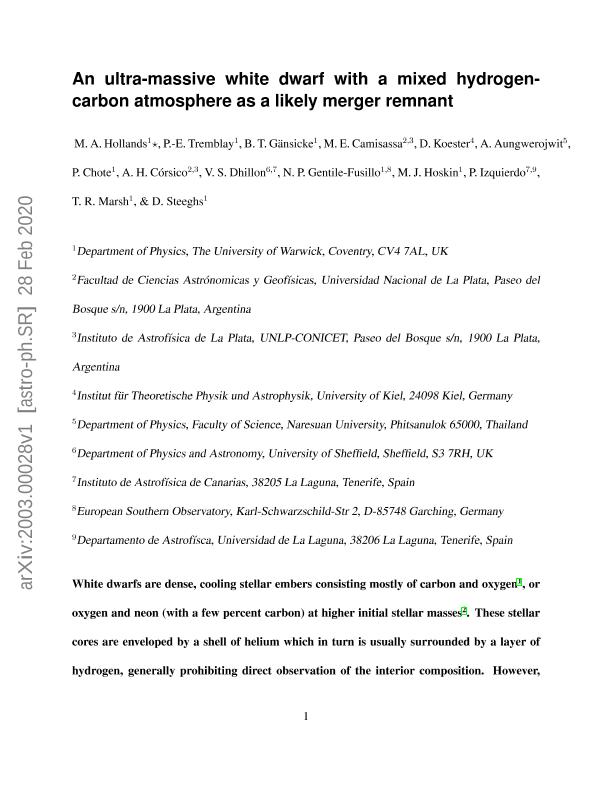Artículo
An ultra-massive white dwarf with a mixed hydrogen–carbon atmosphere as a likely merger remnant
Hollands, M. A.; Tremblay, P. E.; Gänsicke, B. T.; Camisassa, María Eugenia ; Koester, D.; Aungwerojwit, A.; Chote, P.; Corsico, Alejandro Hugo
; Koester, D.; Aungwerojwit, A.; Chote, P.; Corsico, Alejandro Hugo ; Dhillon, V. S.; Gentile Fusillo, N. P.; Hoskin, M. J.; Izquierdo, P.; Marsh, T. R.; Steeghs, D.
; Dhillon, V. S.; Gentile Fusillo, N. P.; Hoskin, M. J.; Izquierdo, P.; Marsh, T. R.; Steeghs, D.
 ; Koester, D.; Aungwerojwit, A.; Chote, P.; Corsico, Alejandro Hugo
; Koester, D.; Aungwerojwit, A.; Chote, P.; Corsico, Alejandro Hugo ; Dhillon, V. S.; Gentile Fusillo, N. P.; Hoskin, M. J.; Izquierdo, P.; Marsh, T. R.; Steeghs, D.
; Dhillon, V. S.; Gentile Fusillo, N. P.; Hoskin, M. J.; Izquierdo, P.; Marsh, T. R.; Steeghs, D.
Fecha de publicación:
03/2020
Editorial:
Nature Publishing Group
Revista:
Nature Astronomy
e-ISSN:
2397-3366
Idioma:
Inglés
Tipo de recurso:
Artículo publicado
Clasificación temática:
Resumen
White dwarfs are dense, cooling stellar embers consisting mostly of carbon and oxygen, or oxygen and neon (with a few per cent carbon) at higher initial stellar masses. These stellar cores are enveloped by a shell of helium, which in turn, is usually surrounded by a layer of hydrogen, generally prohibiting direct observation of the interior composition. However, carbon is observed at the surface of a sizeable fraction of white dwarfs, sometimes with traces of oxygen, and is thought to be dredged up from the core by a deep helium convection zone. In these objects, only traces of hydrogen are found, as large masses of hydrogen are predicted to inhibit hydrogen-helium convective mixing within the envelope. We report the identification of WD J055134.612+413531.09, an ultra-massive (1.14 solar masses (M☉)) white dwarf with a unique carbon-hydrogen mixed atmosphere (atomic ratio C/H = 0.15). Our analysis of the envelope and interior indicates that the total hydrogen and helium mass fractions must be several orders of magnitude lower than predictions of single-star evolution: less than 10-9.5 and 10-7.0, respectively. Due to the fast kinematics (129 ± 5 km s-1 relative to the local standard of rest), large mass and peculiar envelope composition, we argue that WD J0551+4135 is consistent with formation from the merger of two white dwarfs in a tight binary system.
Palabras clave:
Astrophysics
,
Solar and Stellar Astrophysics
Archivos asociados
Licencia
Identificadores
Colecciones
Articulos(IALP)
Articulos de INST.DE ASTROFISICA LA PLATA
Articulos de INST.DE ASTROFISICA LA PLATA
Citación
Hollands, M. A.; Tremblay, P. E.; Gänsicke, B. T.; Camisassa, María Eugenia; Koester, D.; et al.; An ultra-massive white dwarf with a mixed hydrogen–carbon atmosphere as a likely merger remnant; Nature Publishing Group; Nature Astronomy; 4; 3-2020; 663–669
Compartir
Altmétricas



